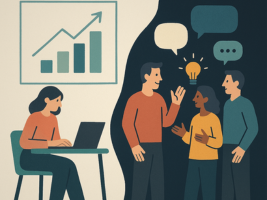This is the third post in a series of six that covers Deeper eLearning. The goal of this series is to build upon good implementations of instructional design, and go deeper into the nuances of what makes learning really work. It is particularly focused on eLearning, but almost all of what is mentioned also applies to face-to-face or virtual instruction. We’ve started with objectives and continued with practice, and we’ll continue on through examples, emotional elements, and putting it together, but here we’re talking about the role of concepts in learning.
There seems to be a funny disconnect. Most ID work I see talks about getting a good objective, and if they’re good they talk about assessment, but then they talk about “designing content”. As if content is this monolithic thing that comes between an introduction and the assessment. We (should) know that is not right. Instead, we need to break down content into its constituent roles:
1. Concepts that guide performance
2. Examples that illustrate how the concepts play out in context
…and as we’ve already talked about…
3. Practice that gives the learner the opportunity to apply the concept in context.
And what is critical here is what is meant by ‘concept’.
Let’s take a step back. Typically, we give learners procedures to follow, or processes to implement, and too often they’re rote. Do this, and then this, and then this. What’s missing here is the reason why we do it in that order and/or that way. There is an explanation of how the world works that guides this. For example, we wash our hands before surgery to avoid contamination, and we do it in a particular order to ensure comprehensiveness. We refer to these explanations / examples as models. Often, we don’t explain the rationale behind our reasons, and this is problematic for two reasons.
1. The first problem is that if we don’t give learners a model to follow, they’re lost if they forget a step.
2. The second problem is that individuals do build models to explain things (it is a phenomenon of our cognitive architecture), and if we aren’t given one, the one we build on our own may not be right. It can lead us astray, and if it is wrong and we find out, we patch it instead of replace it. And so on. At the end, we end up with this Frankenstein’s monster of a model all patched together instead of the right one.
Models are powerful. They give us a basis to explain what has happened, and to predict what will happen. They give us not only a basis upon which to act, but also a basis from which to adapt as things change. If we understand the reasoning behind the steps, we can deal with those unusual, ambiguous, and unique situations on the basis of that reasoning. And I will suggest that what will make a difference to organizations, particularly going forward, is this ability to flexibly adapt rather than execute by rote.
In short, models are a better basis for learners to understand what they are supposed to do and to do it. Let me clarify a bit of terminology: I am talking about causal models that determine what we do and why, that is, how things work. I call these concepts because they’re conceptual models, but I use the terminology rather indiscriminately (shame on me). Technically they’re mental models (in the psychological sense).
There are several issues with models. The first is to be clear what a model is. It is a set of conceptual relationships that create a causal basis for how things work. It can be the operation of a system that gives you the basis to control it, or mechanisms for things that you want to prevent or promote. Ideally, it is not connected directly to specific conceptual details. So something like negotiation needs to be abstracted from any particular deal, and so to any model of microbial infection needs to specify mechanism independent of a specific bacteria (unless you’re actually getting to that level of detail as your learning objective). As identified, it should give you a basis to explain or predict, so that you can use it to guide choices. For example, you might run a mental simulation using the model in a particular context to determine what you should do. In short, a good model gives you a basis for figuring out what to do; how to deal with irritated customers, treat a gunshot wound, or anything else your learners need to do. (To be clear, this is tightly coupled with the admonition when talking about objectives and practice that we should be focusing on decisions, as discussed in the previous entries in this series.)
In addition, models are not necessarily easy to get. Not all subject matter experts (SMEs) are articulate about models, and yet it is critical to obtain them. If you’ve broad knowledge, you may be able to infer them and circulate for validation, but otherwise you’ll need to work in new ways with your SMEs to obtain them. Looking through other resources may be useful as well.
Once you have models, the evidence suggests that finding multiple ways to represent them is useful. My inference is that it gives you more likelihood that one of them will be useful for the learner, and once they’ve got one down, the others will follow. Second, it provides a better likelihood that one of the representations will get activated (that is, reach consciousness and be available for use) when facing a relevant problem. Third, when one gets activated, it increases the likelihood that the others do, so that they’re all available to map to the problem.
One trick to generate multiple representations of a model is to create at least a text version and a diagram. Diagrams capture conceptual relationships as spatial relationships, and are a powerful tool for both understanding and applying. Of course, if the model is dynamic, you may need an animation instead of a diagram, or both can be useful. But also look for other ways to represent the same information, whether via a metaphor or analogy or another way to organize the same model. So, for example, we might look at contamination in the case of hand-washing at the macro level and at the micro level.
The takeaway is that the best basis for guiding learners in practice and in performance is models. We need to get them, and make them visible and comprehensible. Then we’ll use them to guide performance in examples (next post) and in practice. And that’s the best way to help your learners succeed.
x—–x—–x—–x—–x
Here are links to all six parts of the “Deeper eLearning Design” series:
1. Deeper eLearning Design: Part 1 – The Starting Point: Good Objectives
2. Deeper eLearning Design: Part 2 – Practice Makes Perfect
3. Deeper eLearning Design: Part 3 – Concepts
4. Deeper eLearning Design: Part 4 – Examples
5. Deeper eLearning Design: Part 5 – Emotion
6. Deeper eLearning Design: Part 6 – Putting It All Together
x—–x—–x—–x—–x
Written by Clark Quinn
_________________________________
Published on 06-Jul-2015






